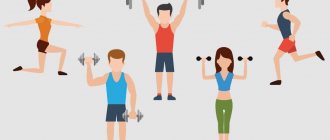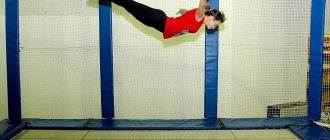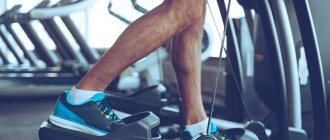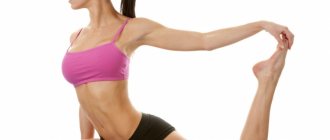How many calories are consumed when doing squats?
Squats are effective exercises for losing weight. Due to their high energy consumption, they allow you to quickly burn a lot of calories and lose weight.
Calorie consumption depends on the weight of the trainee, the intensity of the exercise, weights, clothing, shoes and other factors. On average, up to 50 kcal is consumed within 5 minutes.
To determine individual energy costs, you can use the following calculator
You will burn:
Fat equivalent:
You can achieve a more noticeable result and speed up the weight loss process by incorporating a low-calorie diet and maintaining a drinking regime.
How many calories are burned with 100 squats?
A person weighing 60 kg, squats without weights 100 times for 5 minutes, on average spends 40-45 kcal. Three or four sets of 100 squats will allow you to work out your body perfectly even at home.
How many calories are burned with 50 squats?
Provided that the trainee’s weight is the same 60 kg, he will need 20-22 kcal to perform 50 repetitions. This indicator will vary depending on body weight and exercise technique.
How many calories are burned with 30 squats?
Using a simple calculation, you can calculate that a 60-kilogram athlete spends on average 12-15 kcal for 30 squats. Of course, such an amount is very small in order to feel the result. Such energy consumption will not be noticeable against the background of ordinary household tasks.
In order to increase calorie consumption, squats with a variety of weights. But you should move on to them gradually, without skipping the previous stages of training. Otherwise, there will be negative consequences for the body.
How can squats harm you?
Squats, although a simple exercise, can be dangerous in some cases. First of all, you need to think about how much excess weight increases the load. Perhaps the extra pounds are approaching about 0, which means that squats are not the best choice for losing weight. The problem is that the knee joints are overloaded. Even if your weight is not so critical, the question of how to protect your knees from overload still remains open. Trainers advise using special products from the group of drugs and biological additives - these are chondroprotectors. But if you do squats 2-3 times a week for no more than an hour, you can do without such supplements, you just need to strictly follow the technique of performing the exercise.
Benefit
Squats are a must-have in most training programs because they are not only effective for building muscle, but are also very beneficial for your health. The exercises combine the benefits of strength training and aerobic exercise. The first phase of the squat involves the muscles of the buttocks, legs and abs, and during the second phase a force load occurs due to its own weight.
Tense muscles are supplied with a large amount of oxygen, which activates local fat burning processes. Enhanced capillary microcirculation improves cellular nutrition. As a result, subcutaneous nodules are smoothed out and the skin texture is accordingly leveled.
Among the main benefits of squats are the following:
- energy consumption - the exercise involves more than half of the body, which requires a lot of energy;
- leg muscles are strengthened and developed - natural stimulation of testosterone production allows you to quickly build muscle mass;
- body coordination, mobility and leg endurance improve – regular training allows you to withstand heavy loads;
- the respiratory system develops;
- blood circulation in the pelvic organs is normalized;
- muscle elasticity increases, which has a positive effect on performing other sports exercises;
- joints are strengthened - with the correct technique, the load is distributed evenly, training the endurance and strength of the knees and hip joints;
- Regular training protects against hip fracture, relieves cramps and weakness;
- the abs are worked out - the abdominal muscles actively take part in the work;
- the hip line improves, a beautiful shape of the buttocks is formed.
Squats are versatile - they can be performed by experienced athletes and beginners, in the gym or at home, outdoors and indoors. A variety of options allows you to work out the required muscle group and get the desired effect from the exercise.
Is it possible to lose weight with squats?
How many calories are lost from squats is one part of the question, but the second is even more important: is it possible to lose weight with this exercise? Of course, it should be included in the training complex for weight loss. It is important to choose the optimal rhythm, load, number of repetitions and duration of training.
To help squats help you lose weight, spend 7-10 minutes warming up before exercise. And keep in mind that even with such an effective exercise, you will not be able to burn fat locally, that is, remove excess fat only in the thighs or buttocks. Separately, a squat will help you lose weight, but the process will be less effective compared to a full workout that includes all muscle groups.
Thus, you can do squats to lose weight and burn calories at home, but if you sign up for a gym, it’s better to start doing full exercise, supplementing squats with other exercises.
Types of squats
There are many variations of these exercises. They are classified according to the location of the feet, manner of execution, depth and location of the center of gravity. Each type has a unique effect on the body and uses a specific muscle group. The most popular are:
- classic - the most common option, aimed at working all the muscles of the lower extremities;
- plie - the gluteal and quadriceps muscles are involved, as well as the inner surface of the thigh;
- sumo - have a complex effect on the muscles of the legs, buttocks and thighs, develop body mobility and improve the flexibility of the hip joints;
- wall squats - work the quadriceps, soleus, calf and gluteus maximus muscles;
- squats with jumps - increase the overall effectiveness of the workout;
- scissors - alternate the load on the front and back muscle groups of the legs.
In addition, there are partial squats that are classified as cardio strength. They are performed at an intense pace and use muscles that even standard deep squats do not work.
How do squats burn calories?
Standard squats are a basic exercise that can be performed anywhere, even at work during a break. With its help you burn calories and get many additional effects:
- Squats work your calves, quads, hamstrings, and ankles. The complex work of all these muscles starts the process of burning calories.
- Under load, the buttocks are tightened - they become more elastic and cellulite goes away.
- When squatting, even the abdominal muscles work (they help maintain balance), so you additionally pump up your abs.
The work of many muscle groups and individual fibers makes squats a good fat-burning exercise, especially if you use a barbell or other weights.
Correct exercise technique
Squatting incorrectly can strain your lower back, injure your joints, damage your ligaments, and cause cramps. Training should begin with a set of warm-up exercises, and squats should be performed slowly and smoothly so that the muscles of the thighs, buttocks and abs feel the load.
General biomechanics of the exercise:
- The legs are shoulder-width apart, the feet are slightly turned to the sides, the body is relaxed.
- When squatting, your knees and toes move in the same direction. The body weight is smoothly transferred to the heels. The feet are pressed tightly to the floor and do not come off.
- The back is straight, there is a slight arch in the lower back.
- When squatting, move your buttocks back, as if trying to sit down on a chair. Take a deep breath.
- Lower until the thighs are parallel to the floor.
- Exhale as you rise. Before reaching full straightening, they immediately begin to move downwards.
Regardless of the type of squats, the same basic rules apply, by following which you can be confident in the effectiveness and safety of the exercises:
- the weight is concentrated on the heels, the foot is firm, the toes are free;
- the gaze concentrates straight ahead on a specific point;
- knees should not go beyond the level of the socks;
- the back is straight, slightly arched in the lower back,
- the shoulder blades are brought together so that the spine is straight;
- the chest is straightened, stretches forward and upward;
- additional weight is introduced gradually.
Pain that occurs during exercise indicates a violation of the technique, and as a result, a negative impact on the body. If pain occurs, you should carefully review the mechanics of the exercise and eliminate the error.
Your arms can be held in different positions: stretched forward parallel to each other, placed on your belt, clasped in front of you, or folded behind your head, slightly bent at the elbows. Any option will be correct.
Performing full range of squats helps develop the core muscles of the legs and prevents fatigue after long sessions.
How many calories to burn to lose weight
It is possible to gain weight with squats, provided that you do it regularly and reduce your caloric intake by 20%. However, there are some nuances here. When working at a certain pace with the same number of repetitions, the body quickly adapts to the load.
If you do not change your training strategies within 1.5-2 months, a sports plateau occurs. Extra pounds are not lost, muscle hypertrophy stops. In addition, the lack of effect reduces motivation and discourages the desire to exercise further.
To keep muscles toned and stimulate the process, you need to:
- change speed more often;
- leg position;
- resort to modifications.
Contraindications
Excessive axial load on the musculoskeletal system can cause intervertebral hernia or damage to the Achilles tendon.
You should avoid squats if you experience pain when walking and running. This exercise is also prohibited for the following diseases:
- knee and ligament injuries;
- radiculitis;
- scoliosis;
- hypertension;
- diseases of the cardiovascular system;
- osteoporosis;
- phlebeurysm;
- knee diseases;
- diseases for which any physical activity is contraindicated.
Being overweight puts extra pressure on your joints, so squats should be performed with extreme caution. You need to start with a small number of repetitions, carefully observing the body's reaction. Before starting classes, it is recommended to wrap your knees with an elastic bandage.
Squats with additional loads are especially dangerous. They can seriously harm your knees and joints, so you should be very careful when choosing a weighting material.
Squats are an energy-intensive form of exercise that is often used for weight loss. The result of regular exercise will be a slim figure, good health and excellent mood.
How to do squats correctly? Standard technique
To start, you need to place your feet slightly wider than your shoulders, with your hips above your knees and your knees above your ankles. It is important to lower your shoulders and not pull them towards your ears, so as not to further strain your lower back. The arms are extended forward, parallel to the floor, palms facing down. It is permissible to bend your elbows and turn your palms towards each other.
Execution process:
- The squat begins with inhalation from the stomach.
- Pull your hips back slightly so your knees begin to bend.
- The pelvis moves back, while the shoulders and back remain straight.
- As you lower, your eyes should look forward and your back should remain neutral.
- If there is no discomfort, the hips drop slightly below the knees. To keep track of how much is left to the floor, you can use a box behind you.
Being in the lower position, you need to tense your abdominal muscles, exhale and use your heels to return to the starting position. Based on this technique, you can calculate how many calories are spent when squatting. To increase the rate and spend the time allotted for training more efficiently, you should use weights.
The weight must be selected in such a way that it is possible to do twelve repetitions per approach. To begin with, it is better to try a comfortable weight, and then gradually choose one with which it is difficult (but realistic) to complete the twelfth repetition. A good solution for working out in the gym would be barbell squats, back squats and Smith machines.
Building an ideal training process
To determine for yourself how many times a week you need to go to the gym in order to get optimal results, you need to remember some basic principles (due to which you will be able to squeeze out the maximum that they can give from your workouts).
First of all, these principles relate to the frequency, intensity and complexity of classes.
There are a few more points that should not be forgotten when drawing up a training complex, since it must necessarily include the following types of loads:
- warm-up;
- stretching;
- cool down (cooling muscles).
Now let’s look at each element in more detail and try to find the answer to today’s most important question.
Warm up (warm up muscles) and cool down (cool down muscles)
This type of activity can be safely included in exercise sets, but not performed at such an intense level. For example, if you plan to run on the treadmill for 45 minutes, then you can walk on it at a moderate pace.
Remember, warming up:
- Increases blood flow to muscles;
- Reduces the chances of muscle or joint injury;
- Passes within 5-10 minutes at minimum intensity.
It is important to remember that cooling:
- Prevents blood from pooling in the extremities;
- No more than 5 minutes pass (the intensity level should gradually decrease).
Stretch marks
You need to stretch your muscles both after the warm-up and after the cool-down. Its role is very important, since it is thanks to stretching that the risk of injury is reduced, and the feeling of stiffness after exercise disappears and at the same time flexibility develops.
Important
: A very common mistake is to stretch before warming up. Such actions are fraught with injury, since the muscles first need to be warmed up and only then stretched.
How often should you train?
People are advised to be active daily and do light aerobic exercise 3-5 times a week (cycling, swimming, brisk walking). Those who lead a sedentary lifestyle need to get used to working out in the gym gradually, starting from 2 times a week.
The most effective way to work would be:
- Monday - training in the gym;
- Tuesday - aerobic exercise;
- Wednesday is a day of rest;
- Thursday - classes in the hall;
- Friday - aerobic exercise;
- Saturday and Sunday are rest days.
How long should you train?
According to scientists, a person should spend at least 20 minutes a day on sports (warm-up and cool-down are not taken into account). The maximum interval between exercises is 1 hour
For those who are just starting to go to the gym, it is important to first increase their time under load from 10 minutes to 20-25 minutes. It’s best to start with exercises that you can do at home, such as push-ups, squats, abs, etc.
How difficult should it be?
Some athletes in the gym work hard, so their training time stretches over long periods, while others, on the contrary, work with high intensity and therefore invest in a record time. So it turns out that intensity is an important factor that influences the amount of time required, the intervals between classes and the number of approaches.
Beginners are advised to start with low-intensity physical activity. After this, you need to gradually increase the duration of training (the total amount of time under load), and only then can you increase the intensity.
Each athlete must determine for himself how often and for how long to train. This figure is flexible enough in itself, so everyone has everything they need to derive the optimal value.
So it turns out that to answer the question of how many times you need to visit the gym, you must first analyze all the parameters listed above, and then come up with something that is suitable for you.
There is an option to take the simple route and give instructions to train everyone and everything for one hour 3 times a week. Only the results from this approach will be small. And why all? Yes, because there is no adjustment in them to their goals, their body and their daily routine.
Now is the time to move on to considering the physiological side of training.
Contraindications to doing squats for weight loss
Almost everyone can do squats, if there are no health problems. Squats should not be performed by people with:
- injuries to the hip joints, ankles, knees;
- chronic state of overtraining, muscle inflammation;
- fractures of the ribs and lower extremities during the recovery period.
Deep squats are prohibited:
- pregnant women due to increased pressure in the pelvis, abdominal contraction, spasm of the smooth muscles of internal organs;
- people with excess body weight over 30 due to high pressure on the knees;
- insufficiently flexible people who cannot walk parallel to the floor without lifting their heels off the floor and causing pain in their knees.
Reviews show that squats for weight loss are very effective. And if you add a healthy diet to this, then toned buttocks and slender legs and thighs will not be far off!
Sports are an integral part of those who lead a healthy lifestyle and take care of their health. Well, squats are one of those exercises that are included in any training block, both for men and women. Regardless of what goal a person is pursuing - losing weight or vice versa, gaining muscle mass or simply tightening muscles, squats are considered mandatory for everyone.
How to burn 1000 calories
Sports will help burn calories that enter the body with food. Active exercise will speed up your metabolism, giving you a leaner body. The muscular system will begin to activate, this will make it possible to burn even more calories.
How to Burn 1000 Calories: Running
Running is the most effective method to get rid of excess calories.
Two hours of such activity is enough, and the figure will acquire ideal shape. To get the most pronounced results, you should run uphill.
How to Burn 1000 Calories: Cycling
A bicycle is not only a way of transportation, but also an opportunity to burn calories.
Just 75 minutes of activity, and subcutaneous fat will begin to burn intensively.
You need to be prepared that all muscle groups will hurt the next day. This is a good sign, since the whole body is involved in the work when riding a bicycle. To get the most efficiency, your riding pace should be constantly varied.
How to Burn 1000 Calories: Jump Rope
A jump rope is considered one of the universal devices that helps to cope with excess weight.
The jump rope is considered one of the universal devices that helps cope with excess weight.
If you jump without stopping for 50 minutes, you can burn up to 800 calories. It's difficult to do this without a break. Beginners are advised to divide the exercise into several approaches.
How to Burn 1000 Calories: Burpees
Burpees are a cardio exercise.
This activity involves all the muscles of the body. One approach burns 1.5 calories. To get rid of thousands of calories, you need to do at least 700 burpees.
If you do the exercise for ten minutes, you will be able to burn about 150 kcal.
How to Burn 1000 Calories: Walking
One of the simplest exercises is walking.
If a person moves at an average pace, then in one hour you can get rid of 200 calories. To burn 1000 kcal entering the body, you need more time - at least five hours. Speed also matters.
The benefits of squats for the body
Squats have a pronounced positive effect on the body. In addition to the fact that they can help you lose extra pounds, they have a number of beneficial effects. This:
- Improving blood circulation in all tissues and organs,
- Increased skin tone and elasticity,
- Correction and strengthening of posture,
- Strengthening all muscle groups, building them up,
- Improved metabolism
- Burning fat cells
- Improved coordination
- Beneficial effect on joints and tendons,
- Development of strength qualities and indicators,
- Increased flexibility.
It is important to note that if all rules of technique are followed, the exercises are not dangerous.
Advice from experienced trainers
Trainers can advise on how to effectively and correctly perform this or that type of exercise. According to the recommendations of sports mentors, first of all, the calorie content of a person’s usual diet should be calculated. Next, it is adjusted in accordance with the person’s height and weight, after which an individual set of exercises is prescribed. When performing squats, it is extremely important not to “move” your knees forward, otherwise the entire load will be transferred to the knee joint, which can have a negative impact on the condition of the joints.
A competent approach to performing squats and alternating different types of this exercise strengthens the muscles and tone them, eliminating weakness and sagging.
Harm from squats
As you know, there is a downside to the coin, and squats can sometimes do more harm than good. How does this happen?
- During their execution, the main load falls on the knees - they suffer the most and then can manifest themselves with sharp pain.
- Improper execution technique can result in too much stress and even injury.
- Before performing squats, you need to warm up and stretch. If this is not done, then later, during exercise, you can damage the ligaments and tendons.
Squats are contraindicated:
- People suffering from knee problems
- For those who are overweight,
- For those who have problems with the spine,
- People suffering from diseases of the cardiovascular system,
- Children: they should perform squats more carefully and strictly under adult supervision!
How many calories are burned when running 1, 3, 5 and 10 km
Modern society has become very responsible and enthusiastic about not only its own health, but also its appearance.
Most likely for this reason, various methods of losing weight are becoming more and more relevant: diet, body wraps, acupuncture, hypnosis, and, of course, regular physical activity.
Of course, of the many variations that make it possible to localize unnecessary and even harmful fat deposits in the human body, physical activity is considered the most useful and effective.
However, in comparison with fitness training, yoga, dancing, and many others, running is still in a significant priority position.
According to nutritionists and physical education experts, due to proper jogging, the human body receives an incredible shake-up in every cell, thereby putting all the physiological processes in it into action. It is impossible not to emphasize such an important fact that the benefits of running are very multifaceted.
Important!
So, for example, against the background of rapidly burning kilograms, metabolism and water balance are fully stabilized. In addition, the circulatory system of the entire human body is significantly renewed, the vessels acquire the necessary elasticity.
Also, regular and proper running, even over short distances, helps improve brain function, strengthen muscles, and the immune system. From a psychological point of view, after jogging, a powerful background of endurance is formed in a person, and, of course, the mood improves.
However, with all these advantages about running, one cannot help but say that only the right approach to this type of physical activity will allow you to achieve the desired result. You can figure out this issue yourself - with the help of special literature and Internet resources, as well as by seeking advice from instructors.
It is important to understand the fact that when running 3 km, how many calories are burned accordingly, each person striving for an ideal weight will be able to individually create a schedule for such physical activity. In addition, every candidate who is losing weight has the opportunity to take advantage of expert advice in this matter. As for running for slimness, a distance of 3 kilometers is highly recommended.
However, we must not forget about the individual characteristics of each organism, its metabolism, its physiological activity, willpower, desire and, of course, health status
As for running for slimness, a distance of 3 kilometers is highly recommended. However, we must not forget about the individual characteristics of each organism, its metabolism, its physiological activity, willpower, desire and, of course, its state of health.
Taking into account the above aspects, the calories spent on such a run are calculated. Many people strive to follow certain standards and have a great desire to find out how many calories can be spent when running 3 km.
However, in this case, one cannot deviate from a person’s own capabilities and individual approach to this type of load. At the same time, experts note one very funny pattern.
It turns out that in a person with a larger weight category, fat deposits are localized at a faster pace, and a significant amount of calories are burned along with them. If we talk about the main criteria, thanks to which it is possible to make an individual calculation of the required physical activity, then these include:
- own weight;
— duration of training;
— period of jogging (time of day);
- the number of calories per daily meal.
For beginners losing weight in this way, it will be useful to know that during morning workouts the body perceives loads in a dual amount, which means there will be a corresponding effect.
It is interesting to note another important fact that will allow you to quickly achieve the desired result - running 3 km, combined with a correct daily routine, which includes several aspects, namely: a balanced and dietary diet; good sleep; vital activity during the day; walks in the open air.
Advice!
Thus, having an idea of what running 3 km is and how many calories are burned during a given physical activity, anyone can easily restore their physical shape and sufficiently reduce kilograms. However, you should begin this method of losing weight progressively, without neglecting your own health.
General information about squats
Squats are included in all training programs to improve muscle tone. Different combinations of squats will burn extra calories and pump up your gluteal muscles. Fat in women usually accumulates in the lower part of the body (hips, buttocks, legs), squats are one of the best ways to tighten problem areas.
The exercises combine anaerobic and strength exercises. Rising from the floor, a woman lifts her own weight, the heartbeat quickens, the blood is enriched with oxygen - this chemical reaction causes fat deposits to be burned and lose weight. In problem areas, squats build muscle tissue and “displace” fat. The main thing is to pay attention to how to squat correctly to lose weight.
Correct squat technique for weight loss
Squats for weight loss should be performed in several approaches with a time interval of five minutes, but not 100 times at once. Depending on your individual physical fitness, you need to set the starting level. For example, during the first approach you perform 15 times, during the second - 18 times, during the third - 20 times and during the fourth - 25 times.
Every day you should increase the number of squats in one approach. The interval between approaches also needs to be reduced little by little. Your goal is to feel pleasant tension and muscle pain, but not quickly tire your body.
Squats burn calories if you perform them parallel to the floor. You need to perform the movement as if you were trying to sit on a chair. The angle at the knees should be 90 degrees. But you should not lift your heels off the floor. There is no need to perform full-length squats, almost touching the floor. Inhale and begin to lower yourself gradually, feeling the tension in your hips and buttocks. When you lower yourself parallel to the floor, slowly begin to rise to the starting position and exhale.








